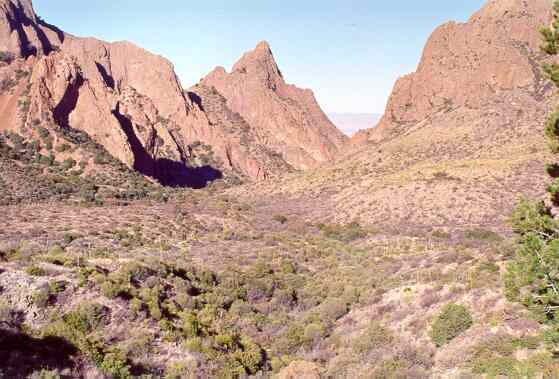
Alluvial fan of mountain debris in a canyon of the
Chihuahuan Desert (Big Bend National Park, Texas)
Desert soils are formed over thousands and millions of years, as the major mountain ranges are eroded by "weathering" - a combination of rain, wind, alternate freezing and thawing and chemical processing. The debris of fallen rocks and finer particles accumulates at the base of the mountains and is "sorted" naturally as rainwater carries the smaller particles downwards into the valley floors, creating the gravels, sands and silts of the lowland deserts, and leaving the larger fragments further up the mountain canyons. In fact, these mountains will eventually be buried by their own accumulated debris!
But the differently sized particles created by this process are, initially, not soils that are able to support plant growth. They are simply mineral particles, like the grains of a sand dune, and they need to be stabilised and bound together in a structure. This again is a long process, taking tens, hundreds or thousands of years, and it is done initially by microorganisms that form desert crusts - often termed microbiotic crusts or cryptobiotic crusts. These microscopic organisms include desert lichens and cyanobacteria. By synthesizing their own organic matter (from carbon dioxide in the atmosphere), deriving their energy from sunlight (photosynthesis) and fixing atmospheric nitrogen gas into proteins and other cellular constituents, they gradually build up the organic matter content of the soil. Organic matter from the dead remains of these organisms stabilises the soil and also acts as a sponge to hold water, so that ultimately higher plants can become established.
In the image above, we see an advanced stage of this process - a great fan of mountain debris that has stabilised and supports a community of shrubs and herbs in the upper region of a mountain canyon. Near the bottom left side of this image we see a zone of specially dense and lush, green vegetation. Here the plants are growing in a gully that receives the water than drains from the slopes. Notice also that the vegetation on the slope at the right of this image is quite different from that on the left, where small trees are growing in ribbons up the mountain slope (see the image below). This difference is caused by differences in exposure to the sun - the slope on the left is shaded during the hottest times of the day (we can see deep shadows on this slope) and so the plants are less water-stressed than on the exposed right-hand slope.

Trees in a mountain canyon of the Chihuahuan Desert (Big
Bend National Park, Texas)
GO TO: